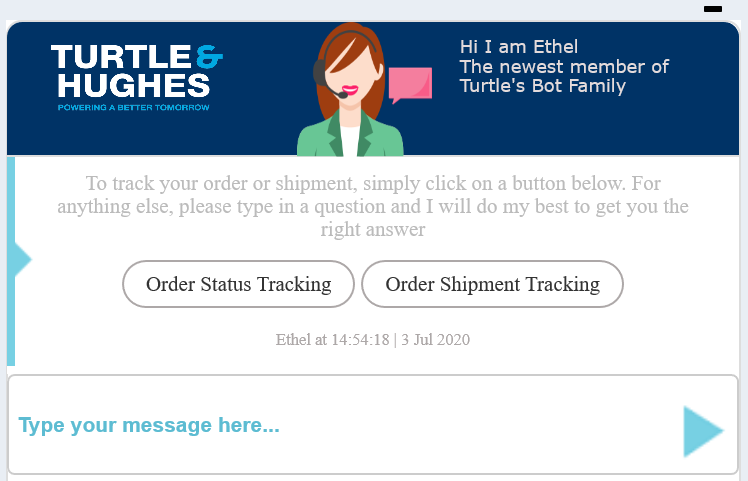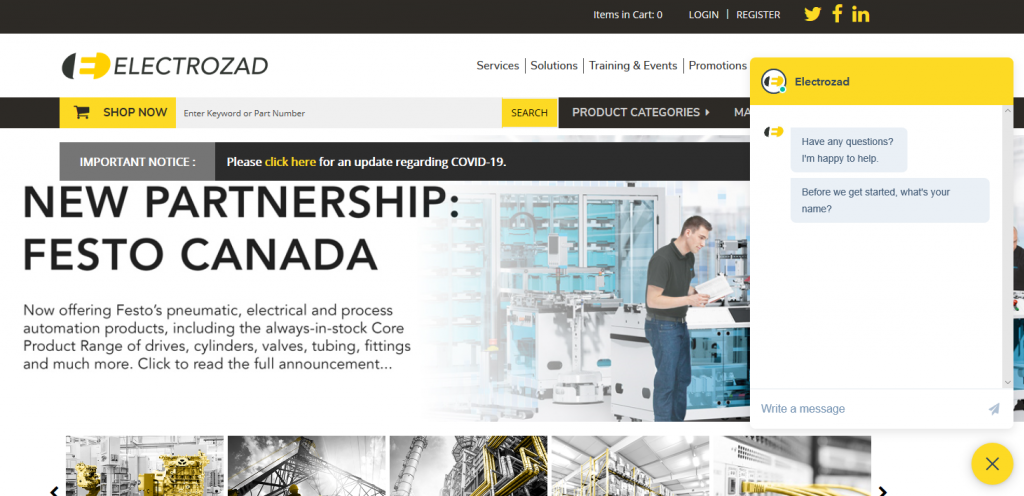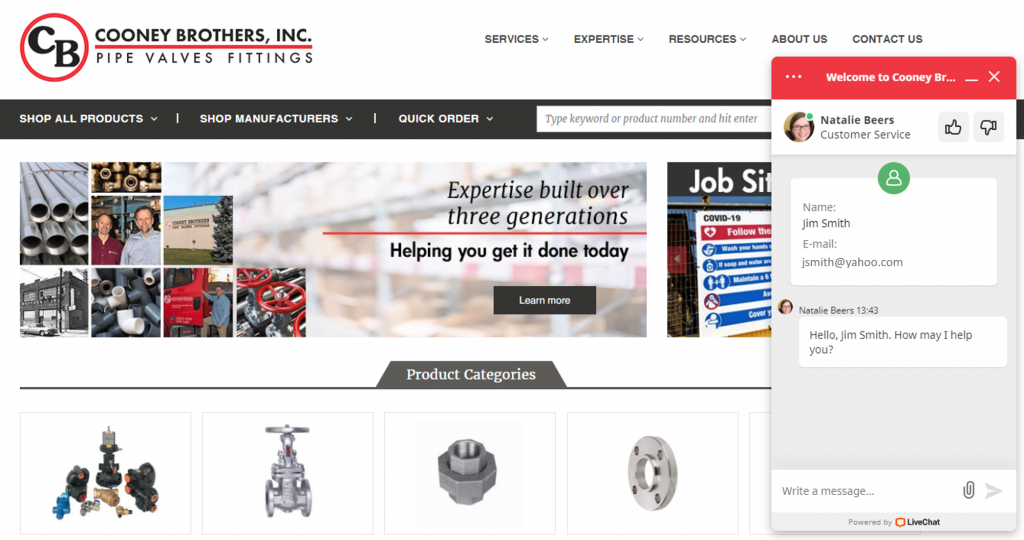Pros and cons of 5 chatbot platforms that can talk up your business
Thinking about integrating a chatbot into your B2B eCommerce site? Check out our reviews of these five popular chatbot platforms, along with the pros and cons of each:
Technology continues to evolve and expand the wholesale distribution and manufacturing markets. While there are still some traditionalists who believe an exclusively brick-and-mortar business model is the best way to serve customers, many forward-thinking businesses are convinced technology and a digital presence are essential to their sustainability.
Gartner agrees. The industry researcher predicts that by 2022 70% of customer interactions will involve technology such as machine learning applications, chatbots, and mobile messaging. That’s a huge jump considering two years ago, when these technologies were just emerging, customer interactions were only at 15%. This drive in technology is predicated by buyers who want more options and flexibility when they interact with businesses.
In the B2B marketplace, chatbots are especially gaining popularity – even more so than with consumer retailers. These applications, which integrate with a website, online messaging platforms, and other apps, help businesses automate communication with people by simulating human-to-human conversations to answer questions, solve problems, and direct them to further support, if needed. Buyers are turning to these messaging apps more frequently because they see them as a faster, more convenient way to get assistance, but businesses are seeing its benefits as well. With machine-learning programs handling more basic customer service requests, staff can work more efficiently and focus on higher-value customer support. These efficiencies are expected to save companies overall nearly $8 billion a year by 2022, according to Juniper Research.
If you’re a wholesale distributor or manufacturer considering adding a chatbot to your digital toolkit, this post will explain the application’s multiple uses and benefits and familiarize you with five chatbot platforms that can help you better serve customers.

Chatbots as a business tool
Think of a chatbot as a member of your customer service team that interacts with site visitors via a chat interface that can be accessed on any page of your website. This chatbot requires some training and programming, but once it is onboarded, it will work 24/7 to assist potential buyers and customers. The more basic type of chatbot is preprogrammed with a set of standard questions so that when a person chooses one of the questions, the chatbot responds with a predetermined, correlating answer. The more advanced (and more prevalent) chatbot operates with artificial intelligence (AI) technology that trains the program to perform more advanced, human tasks. AI chatbots utilize machine learning and natural language processing to help understand human intent and respond in kind. As a result, AI chatbots are able to suggest a viable answer by applying information gathered from their conversations and drawing conclusions based on those previous situations. The more experiences the chatbot has with humans, the more accurate it becomes and better it performs.

These intuitive applications incorporate natural language and context, and can be programmed to use regional terminology, as well as translate misspelled words and abbreviations. Even when extensive dialog is used by a site visitor, many chatbots can still understand the core of the questions asked and maintain a cohesive discussion. More importantly, they can identify when they do not have enough knowledge to answer a question and bring in a human counterpart to assist.

Customer service support is the primary benefit of chatbot applications, but they also perform key functions that streamline your sales efforts:
- Lead generation: Chatbots engage with visitors to understand their business needs, the products and services they are interested in, their communication preferences, and more. They can also conduct surveys and ask questions in a way that isn’t tedious to buyers, as traditional forms can be.
- Lead nurturing: Once initial leads are generated, chatbots can segment the leads and follow up with pertinent, personalized content. Regular interaction with prospects helps build trust and confidence in your business and encourages deeper engagements. With the information gathered, the chatbot can then hand off the qualified prospect to your sales team who can help strengthen the initial connections made.
- Scheduling: Some chatbots can even act as virtual assistants and schedule meetings on behalf of sales members. If a prospect interacts with a chatbot asking to learn more about your company and offerings, they can sync directly to your sales teams’ calendars to schedule a business pitch or see a demonstration of your products.
- Frontline sales support: If you have items that are sold out due to high demand, don’t make it known to your buyers. Instead, include a “click to chat” feature next to the out-of-stock item to connect a buyer to a live person to ask about product availability. Michael Powers, an eCommerce and digital marketing expert who helped build Hill & Markes’ digital branch into the powerful business tool it is today, says chatbots help buyers get immediate answers. “You never want to show a customer an item is out of stock,” asserts Powers. “A ‘click to chat’ link in the item availability field helps buyers obtain instant product information and gives your customer service reps an opportunity to secure a sale.”
Another benefit to having chatbots is that they boost efficiency. “The greatest advantage to having a chatbot on our website is that it takes care of the simple and frequently asked questions, thus freeing up time for our internal employees to work on other things,” says Wilford Gosser, Ecommerce & Marketing Manager at Quality Mill Supply.

Chatbots were designed to wear many hats and, by doing so, they can enhance the customer experience, streamline the sales process, and make your entire business run more efficiently and effectively.
Chatbot platforms to support your business
Given the increasing adoption of chatbots in the marketplace, there is no shortage of platforms available. From your basic preprogrammed chatbots to more interactive AI chatbots, developers have built solutions to fit every business need. To help you determine which chatbot provider is best for your organization, we put together a summary of five chatbots currently on the market, complete with features, functionality, and costs of each.
The widely known inbound marketing specialists provide a broad scope of marketing, sales, and customer service platforms to manage your business. Some of their tools are free, including their chatbot software, which integrates with their free customer relationship management (CRM) tool. The HubSpot chatbot can be deployed on almost any social media or messaging system and performs standard bot functions like handling customer questions, qualifying leads, and booking meetings.
HubSpot is not AI-enabled, however, it does offer more personalized, relevant messaging using information captured in their CRM tool. For those who lack coding skills, their easy-to-use tool includes canned templates for different goals and interactions, which can be customized to match your brand’s voice and style. While the chatbot and CRM tool are both free, HubSpot does charge for add-ons such as their marketing, sales, and service management software.
| PROS | CONS |
|
|
LiveChat/ChatBot for LiveChat
LiveChat is a full-scale customer service platform that lets you create unlimited customized greetings based on a number of pre-defined scenarios. LiveChat boasts a great user experience with quick chat responses, customized branding, and animations that attract and engage visitors. LiveChat also has optional survey forms that you can send after a live chat session that gives visitors a chance to evaluate their experience.
While rich with features to streamline your customer interactions, their LiveChat software is not powered by AI. To enjoy the benefits of AI automation, you will have to add their ChatBot extension to their app. ChatBot provides more in-depth functionality like after-hours support, lead qualification, sales meeting scheduling, and triage support by creating support tickets and sending priority issues to live agents. Another feature ChatBot provides is live testing which helps you track and analyze how well your chatbots are working.
LiveChat plans start as low as $16 per month, per agent, with up to 100 chats; with the ChatBot extension, plans start at $50 per month, per agent, with up to 1,000 chats.
| PROS | CONS |
|
|
Olark
While not an AI/machine-learning chatbot, the Olark application does offer automation options like greeting visitors with custom messages, as well as customization tools and live chat reports that update in real time. You can add your company logo to your chat box and choose from different box colors, shapes, and more to match your brand. Olark does not have a native mobile app, but you can connect their software with third-party mobile apps so your team can chat with customers using their mobile device.
Quality Mill Supply uses Olark as their chatbot provider and says it comes in handy when their team members are not immediately available to respond to a buyer’s chat. “If after 30 seconds one of our associates doesn’t respond, the chatbot will automatically reply for us saying we are away from our desks,” explains Gosser. “This is helpful to the user experience as site visitors are not left waiting around for us to respond.”
The chat service provider offers monthly and yearly plans starting as low as $15 per month per agent. You can also choose to purchase add-on features, called PowerUps, which are priced at an additional $29 to $99 per month. They provide businesses extra functionality and features like visitor insights, screen sharing, and a non-branded chat box.
| PROS | CONS |
|
|
From Fortune 500 companies to small business owners, LivePerson is a popular chatbot solution that delivers optimal conversational experiences across a wide range of digital platforms and apps, including Facebook Messenger, Twitter, SMS, and more. Powered by its own proprietary AI technology called Maven, it uses advanced natural language understanding to detect intents and dynamically route conversations to the best chatbot or human agent based on context and predictive attributes.
Standout features include a user-friendly Conversation Builder that allows non-technical employees to customize prebuilt templates or create new chatbots without coding, and an Intent Manager that uses AI to identify and analyze intents in real time and provide actionable insights that are displayed in a visual dashboard.
| PROS | CONS |
|
|
AI chatbot FlowXO is a helpful lead generation tool that can switch to live chat when needed. It also features the option to accept payments in the middle of a conversation and directs the user to a secure payment portal to complete the transaction. Its two products, FlowXO for Chat and FlowXO for Workflow, work in tandem to engage with customers across multiple platforms and apps. Each engagement activates back-end workflows that automatically perform any number of tasks related to the conversation. Their software integrates with over 100 apps and programs, giving you the flexibility to automate the exchange of data between all your platforms.
FlowXO offers a free version of their chatbot that includes up to five bots, 500 interactions, and e-mail support. You can upgrade to one of their paid plans starting at $19 per month that gives you 15 bots, 5,000 interactions, downloadable user data, custom branding, and support.
| PROS | CONS |
|
|
If you’re ready to build an effective digital branch with chatbot functionality, reach out to a member of our Unilog team for help. We offer an out-of-the-box eCommerce solution to manage every aspect of your digital commerce business. Our platform integrates with a number of ERP systems and third-party applications, including chatbot apps like Olark, LiveChat, and HubSpot. Built specifically for the B2B marketplace, our cloud-based system features the latest tools and functionality such as a PIM to house and manage all your product data, a responsive web design for a consistent shopping experience across devices, configurable site search for more relevant search results, and an advanced shopping cart with multiple checkout options. Contact us today!